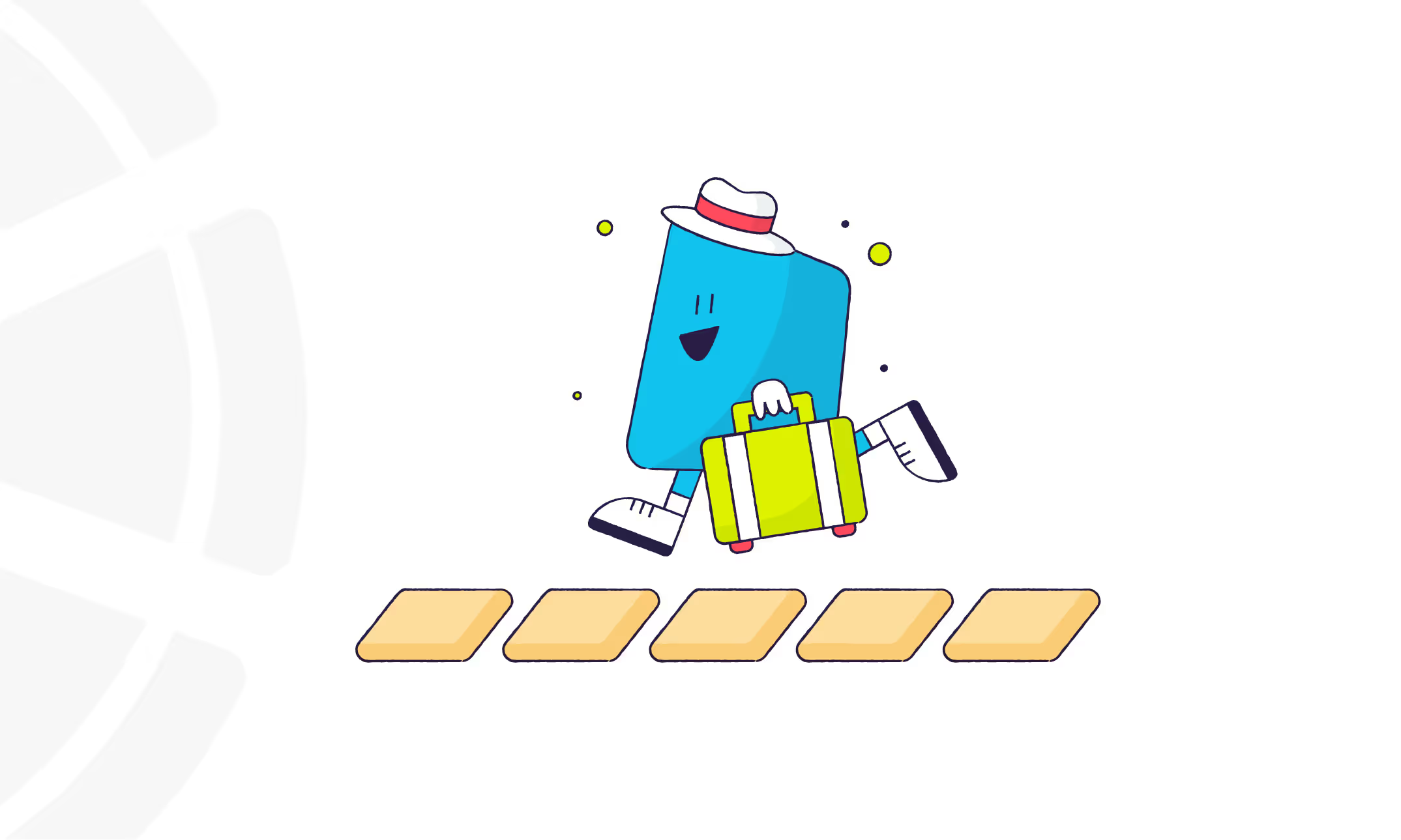The customer journey consists of five stages that the customer goes through from the beginning to the end of their relationship with a brand or business. The customer journey is directly tied to the marketing funnel as both help siphon customers through similar stages. In doing so, customers are satisfied and become repeat buyers and then advocates.
The article below will give insight into each stage of the customer journey and address how businesses can better retain customers by strategically communicating with them, and bolstering their CX departments through surveys and consumer feedback.
Five Stages of the Customer Journey
To better understand the customer journey, let's name the five different stages:
- Awareness
- Consideration
- Decision
- Retention
- Advocacy
A company’s goal is to keep the customer in the journey as long as possible by guiding them from stage to stage. The best way to keep customers engaged is to deliver high-quality and relevant content during each stage of the journey. Businesses can also move customers to the next stage with strategically worded and placed call-to-actions (CTAs).
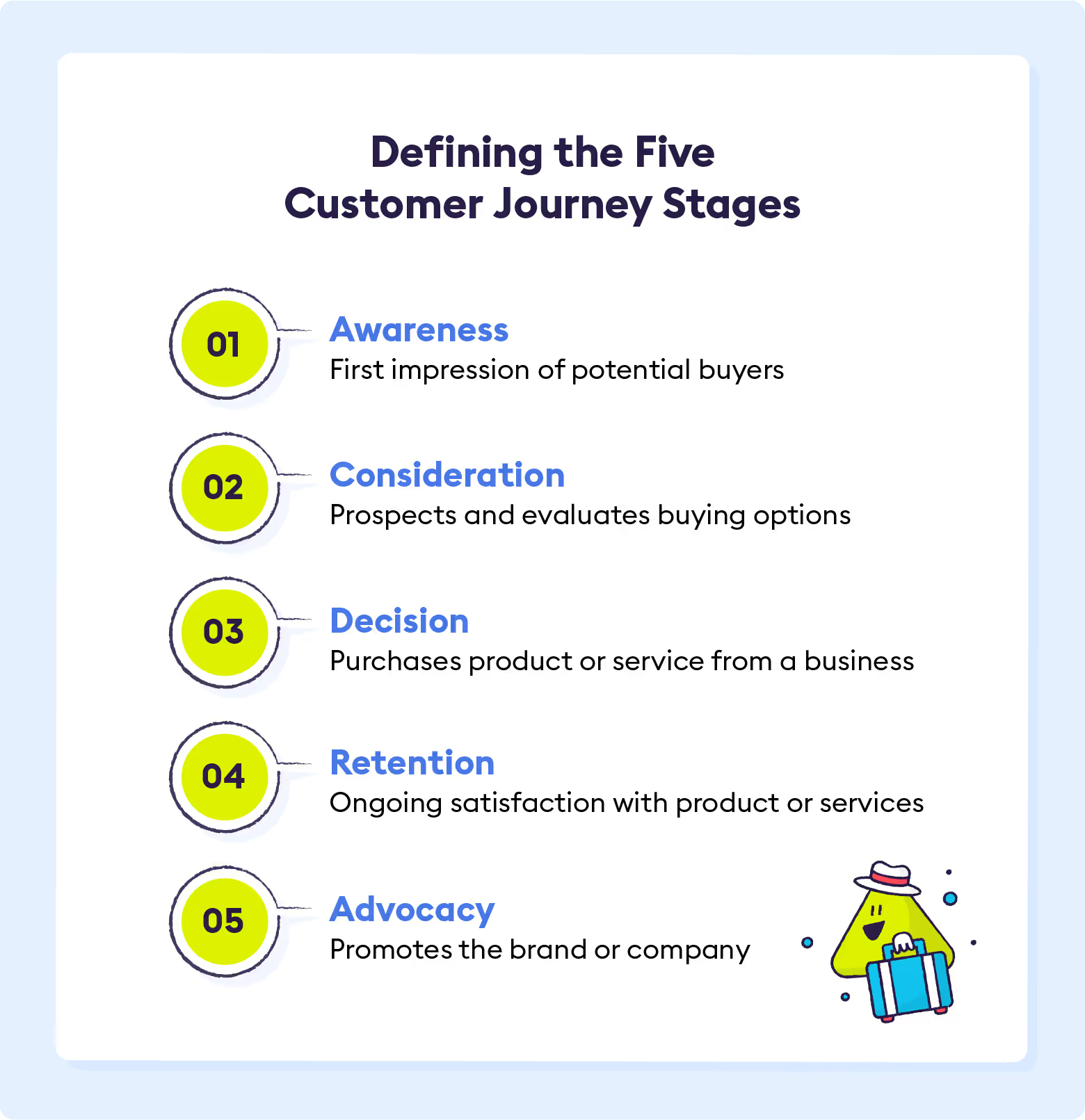
1. Awareness
The awareness stage is when customers initially hear about a brand or company. Typically, customers discover a brand via word of mouth, social media advertisement, testimonial, blog post, or article. If potential buyers come across a business via an advertisement, the ad should quickly address a problem they have or one that’s not even on their radar. Either way, it should make consumers consider potential issues and which company offers the best solution. Below are a few strategies businesses can implement to increase brand awareness:
Address a Problem
This early on in the journey, a company’s main priority is to make sure their marketing efforts create trust between the brand and the buyer. A company should holistically understand and approach its buyer’s problems and issues.
Cast a Wide Net
Businesses should cast a wide net during the awareness stage to draw in as many potential customers as possible. Businesses will strategically want to narrow down their target audience by A/B testing and measuring retention rates.
Survey Customers
Corporations can improve their organic traffic, or word-of-mouth traffic, by surveying their current customers and measuring their Net Promoter Score (NPS). NPS measures how likely a customer is to promote your product. For more information, see our NPS score guide and use our NPS calculator.
Awareness Content to Deliver:
The below content is top of funnel marketing and produces brand awareness to possible customers.
- Online, social media, and television advertisements
- Whitepaper
- Instructional videos
- Industry reports
Tip: This information should be readily available online and specifically on a business’ website. There should also be a clear CTA to help move the customer from the awareness stage to the consideration stage. For instance, “Learn more information here” or “Sign up for our informational newsletter” are strong CTAs for the awareness stage.
2. Consideration
During the consideration stage, customers are fully aware that solutions exist for their issues. Or, an issue exists that they haven’t previously considered and are now contemplating solutions. They have done some initial research and looked at several brands to help alleviate these concerns.
The content and information stemming from a business should show buyers that they are well aware of their issues and can seamlessly address these problems. Additionally, companies must portray themselves as experts in their specific ecosystem or space, and prove that their products and services beat out the competition.
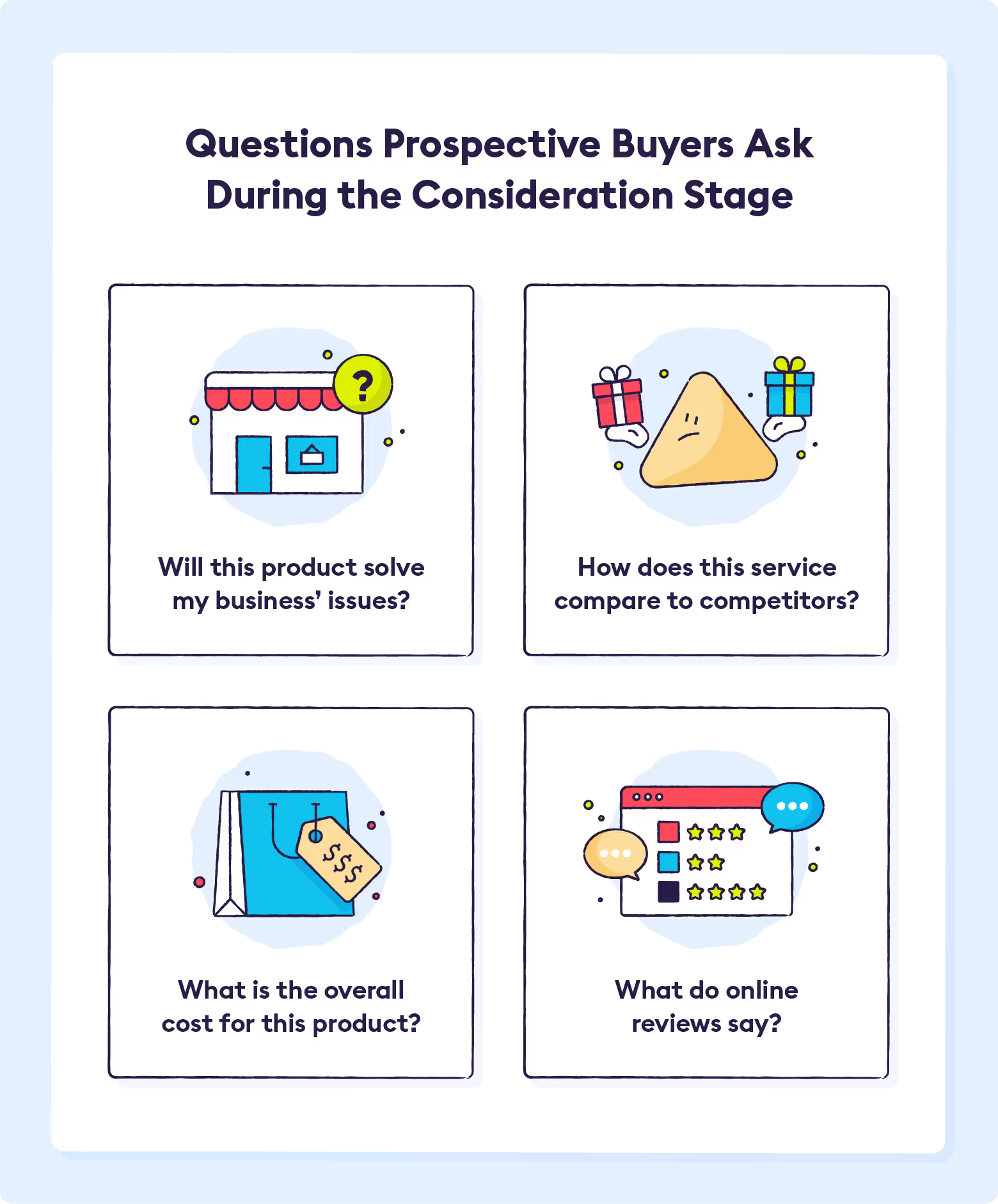
One of the main priorities for businesses during the consideration phase is to make it as easy as possible for buyers to contact the company and ask their initial questions. Having omnichannel and multichannel support systems can help achieve this goal.
Create Omnichannel and Multichannel Support Systems
During the consideration stage, potential customers might try to contact a business in several different ways. Companies should be ready to properly address their needs through omnichannel or multi-channel support. A business must have multiple ways to contact customer support, but not to the extent that they cannot address each query.
If your CX team doesn’t have the bandwidth to quickly respond to inquiries, implement workflows, chatbots, or automated replies—just make sure they’re authentic and notify customers that an actual human will address their needs or concerns by a specific date.
Consideration Content to Deliver:
Consideration content is between the top and middle of the funnel marketing. These are more informational and specific to a company’s products or services.
- Demo videos
- Blog posts
- Case studies
- FAQ section
- Product or service webinar
Tip: Not all of your blog posts have to directly promote a product or brand. They can be informational and based on common search queries from consumers. It’s a good idea to naturally list products and services in these posts but answering the consumer or readers’ questions should be the main priority.
3. Decision
The third stage in the customer journey is the decision stage where a prospective buyer becomes a customer by making an initial purchase. Up to this point, the prospective buyer has done all of their research on a company and its competitors to see which one best fits their needs. The tactics below will help businesses convert potential customers into first-time buyers.
Solicit Online Reviews From Current
One of the largest influences to turn a prospective buyer into a purchasing customer is online reviews. According to a 2020 survey conducted by BrightLocal, 87% of consumers read online reviews for local businesses. Businesses want to ask current clients to post reviews as much as possible to attract and acquire new customers.
Incentivize New Customers With Discounts
Another way to incentivize customers to jump from the consideration stage to the decision and purchasing stage is to offer first-time customers discounts. Businesses can also offer free trials to demos to allow potential buyers to work with and try your product before making a purchase.
Decision Content to Deliver:
Decision content should do two things: either portray consumer trust or incentivize. To get new buyers, companies need to display that they have a positive reputation with current customers. To help persuade customers to make an initial purchase, businesses need to incentivize.
- Customer reviews
- Free trials
- Live demos
- Coupon
- Discount codes
Tip: Companies need to know what factors affect the decision stage. To better understand customers’ general decision process, the CX department should be in synchronized communication with the sales department. Both departments must communicate received customer feedback,i.e., what’s helping turn potential customers into buyers and the main reasons for churning.
4. Retention
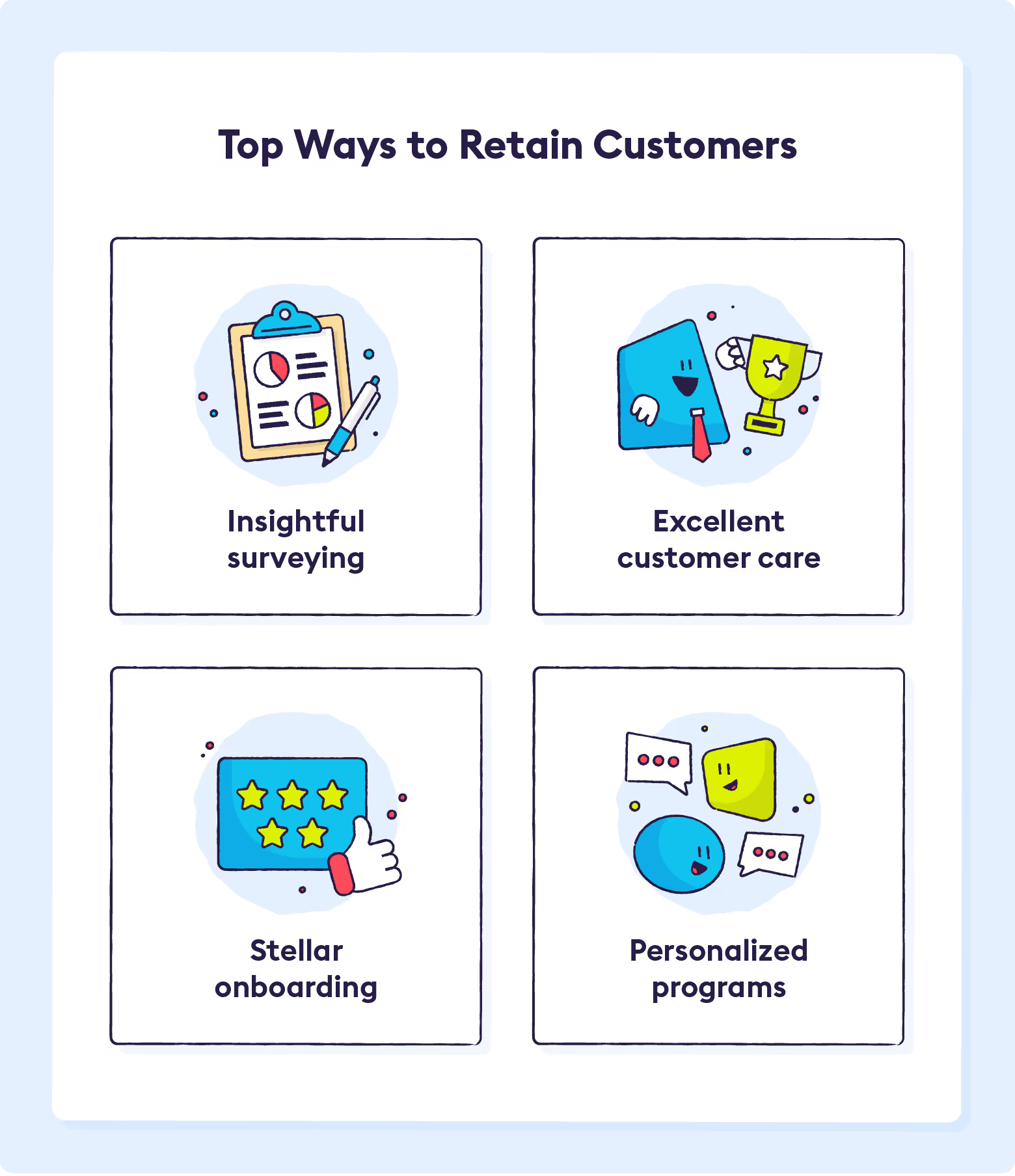
Perhaps the most important stage in the customer journey is retaining clients. Bain & Company discovered that a 5% increase in customer retention can produce more than a 25% increase in profit. It’s best to put effort towards retaining current customers and acquiring new ones. There are several ways to decrease churn rates, the most important of which is to gather survey responses, just make sure to avoid poorly-worded survey questions. Below are several survey methods to gain key customer insight along with how to address pain points.
Conduct Customer Effort Score Surveys
One of the best ways to gather insight into how customers feel about interactions with your brand is to conduct Customer Effort Score (CES) surveys. CES surveys measure how much effort or difficulty a customer felt they had to put in during an interaction with a business. The less effort, the more likely a customer will become a repeat buyer. CES surveys can be a simple questionnaire.
Implement Customer Satisfaction Surveys
Customer satisfaction (CSAT) surveys measure how satisfied a customer is with a business' product or service. Similar to CES surveys, these can be sent anytime a client interacts with a company—after using a demo or resolving an issue with a customer service representative. Once enough CSAT surveys have been completed, businesses can begin to improve their CSAT by reviewing positive and negative feedback and changing CX strategies.
Address Pain Points
Having both CES and CSAT data is pointless unless a company addresses its customers’ pain points. These pain points can be productivity related such as the product is too time or effort-intensive. Another common pain point is process related, where the product isn’t fulfilling the customer’s needs. Regardless of the pain point, these need to be addressed via individual email or phone calls, or through group-wide emails and newsletters.
Retention Content to Deliver:
The content below is mostly in the hands of a company’s CX department. To properly deliver this type of retention content, the CX department might need to be scaled and automated.
- CES Surveys
- NPS Surveys
- CSAT Surveys
- Omnichannel and Multichannel support
- Follow up phone calls
- Testimonial requests
Tip: After collecting all survey feedback (both positive and negative), CX departments should look for patterns and tie these patterns to both known and unknown customer pain points. This information must be shared with the marketing and sales departments at a minimum.
5. Advocacy
Advocacy is the last stage of the customer journey and is likely the most difficult to achieve. At this point, customers are so enthralled with a business or brand that they become advocates. They’ll likely review positive reviews online or refer friends and business partners to a company.
According to Ambassador, “92% of 18-to-34 year-olds say they seek recommendations from friends and family when considering a product purchase.” Advocacy matters. If a business isn’t looking to improve its referral marketing, then the organization is likely falling behind competitors.
Gather Net Promoter Score Data
Another strong customer advocacy and retention analytic is Net Promoter Score. NPS measures how likely a customer will promote or vouch for a brand or business. If a client has a low CES score and high CSAT score, then they’re more likely to advocate for a business. NPS surveys are often sent directly after interactions with customers. Another option is to schedule monthly or quarterly surveys, or to send them directly after new updates have been implemented and used by clients.
Incentivize Customers to Make Referrals
An easy way to get more referrals is to incentivize current customers to share a product or brand. Businesses should send their consumers unique affiliate links to share with others and enter those who share into a rewards program or contest such as, “win a new laptop” or “one-year free membership” somewhere.
Start an Advocate Program
An advocate program does two things. One, it creates a community for a company’s most loyal customers and makes them feel appreciated. And two, an advocate program builds your reputation and brand by having people advocate on your behalf. The advocate program should also tie in with a company’s referral and incentives program.
Advocate Content to Deliver:
A business’ advocate content usually creates a community among loyal followers and customers. It should also make other prospective customers want in on a company’s community and product.
- Referral programs
- Advocate programs
- Incentives
- Social media shoutouts
- User-generated content
Tip: Businesses should not be afraid to ask for reviews. In fact, after receiving a high NPS or CES score from a client, a CTA could be a follow-up email requesting an online review.
How to Use Customer Journey Mapping to Boost CX
Knowing the customer journey is just the beginning for a business to have a successful CX. Companies must also be prepared to address customers’ motivations, pain points, and any roadblocks that come into play.
The best way to strategically plan how to address these issues is to create a customer journey map. A customer journey map helps companies visualize and predict conversion points, issues, and successful interactions. Companies also want to use voice of the customer tools to better predict their customer journey maps early on.
Customer journey maps can help pinpoint exact bottlenecks. For example, if a business has lots of potential buyers trying their demo but a low conversion rate to full-time buyers, then they can research and make strategic adjustments to unclog this congestion. The image below demonstrates the type of survey questions to ask throughout the customer journey.
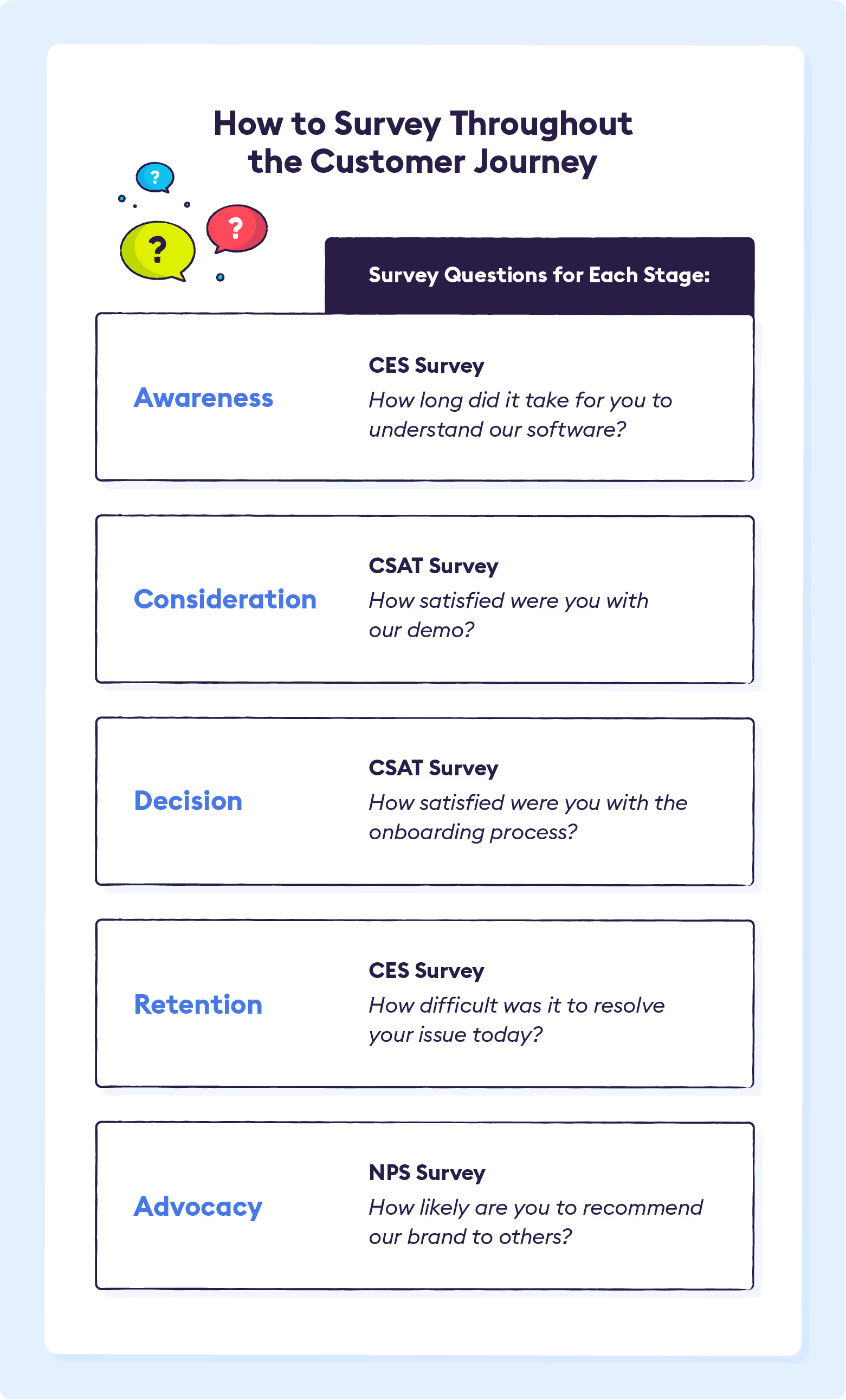
Understanding the customer journey and finding ways to move customers from one stage to the next is essential for businesses to be successful and profitable. Companies must survey and get feedback constantly at each stage and should work tirelessly to fix any bottlenecks. One way businesses can decrease pain points and issues is by updating their CX technology to better serve their clients.
Customer Journey Stages: FAQs
What are the stages of the customer journey?
The customer journey typically includes five main stages: awareness, consideration, purchase, retention, and advocacy. Each stage represents a different phase of the customer’s relationship with a brand.
Why is understanding the customer journey important?
Mapping the journey helps businesses identify pain points, optimize experiences, and deliver the right message at the right time. This improves engagement, loyalty, and conversions.
What happens during the awareness stage?
In the awareness stage, customers first discover a brand or product. Businesses should focus on building visibility, educating customers, and creating a positive first impression.
What is the consideration stage of the customer journey?
During consideration, customers evaluate options, compare brands, and weigh the benefits. Providing clear value propositions, testimonials, and detailed information is essential at this stage.
What defines the purchase stage?
The purchase stage is when the customer makes a buying decision. A seamless checkout process, transparent pricing, and strong customer support are critical to ensuring conversion.
What is the retention stage in the customer journey?
Retention focuses on keeping existing customers engaged and satisfied. Businesses can improve retention through loyalty programs, personalized offers, and proactive support.
What does the advocacy stage involve?
In advocacy, satisfied customers recommend a brand to others through reviews, referrals, and word-of-mouth. Strong advocacy drives organic growth and brand trust.
How can businesses optimize each stage of the customer journey?
By analyzing customer behavior, collecting feedback, and personalizing communication at each stage, businesses can remove friction and create a seamless, positive experience.
Sources: BrightLocal | Bain & Company | Ambassador


